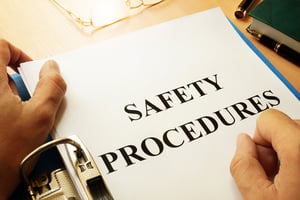One of the most important factors of running a business effectively is keeping employees healthy and safe. Safety Lessons Learned is a series designed to provide examples of workplace accidents that result in injury or even death to help employers recognize hazards and put the proper preventative measures in place (names have been changed to ensure confidentiality).
Lack of Training Causes Injury to Forklift Operator
Joe drives a forklift and operates other heavy equipment at ABC Warehouse in Austin, Texas. While completing a project, he discovered that he needed to adjust the width of the forks, but no one had ever  shown him how. Joe decided to spread the 80-100 pound forks with his fingers. He ended up crushing his pinky, which resulted in a fracture.
shown him how. Joe decided to spread the 80-100 pound forks with his fingers. He ended up crushing his pinky, which resulted in a fracture.
Safety Lesson:
- Train new, inexperienced or transferred workers on the equipment they will be using.
- Provide employees with structured coaching.
- Obtain feedback that verifies employees understand the work tasks, the associated hazards, and the processes and procedures to mitigate those hazards.
Landscaping Worker Suffers Fatal Heat-Related Injury
Tim works on a landscaping crew in Ft. Lauderdale, Florida. The crew was working on a hot summer day when temperatures peaked over 100 degrees. Tim did not drink enough water or take the appropriate amount of breaks during the day and suffered fatal heat-related injuries.
Safety Lesson:
Remind crewmembers to prevent heat-related illnesses by following these simple tips.
- Drink, drink, drink. Employees should drink four cups of water every hour in 15-minute increments.
- Take frequent breaks. Employees need to take breaks to allow their bodies to recover.
- Hang in the shade. Employees can cool down quickly by standing in shaded or air conditioned areas when possible.
Extreme heat, especially in climates like Florida, is both uncomfortable and dangerous. Other ways to stay safe while working in the heat include wearing light colored clothing and a hat, wearing sunscreen and reporting symptoms of heat-related illnesses immediately. For more safety tips on working in the heat, click here.
Experienced Roofer Skips Harness and Falls to His Death
Brian has owned his own roofing company for 25 years. Because of his experience in the industry, he rarely uses a harness, although he requires his team to use protective equipment. While working on a roofing job in New York City, Brian reached for a tool, slipped, and fell to his death.
Safety Lesson:
Always wear fall protection when working on roofs or any other heights where the distance to the ground is more than six feet. Remember, just because you have done this before without getting hurt does not mean you never will. Falls remain the biggest cause of worker deaths in the construction industry. Situations like this not only have a physical impact on the injured employee, there are also financial and emotional implications for all those involved.
Five Ways to Create a Safety Culture in Your Workplace
- Focus more on coaching and less on rules.
- Do not succumb to organizational complacency.
- Engage workers in meaningful safety conversations.
- Let integrity lead your workforce. Do things right no matter who is watching.
- Teach employees how to do their jobs correctly and then hold them to a high standard





